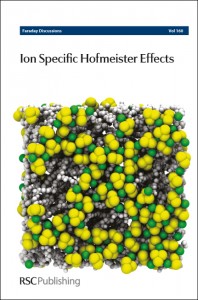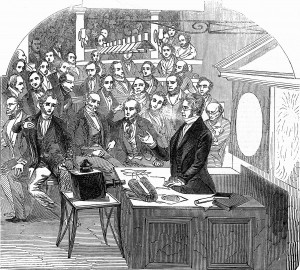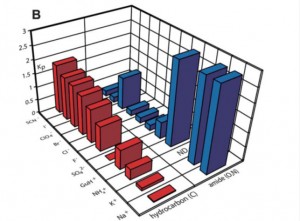We are pleased to announce the publication of Faraday Discussion 160 on ion specific Hofmeister effects.
Take a look at the volume today
 In the volume you can find all the papers and exciting discussion from the conference held at Queen’s College, Oxford, UK in September 2012.
In the volume you can find all the papers and exciting discussion from the conference held at Queen’s College, Oxford, UK in September 2012.
Here are justsome of the highlights:
Introductory Lecture: Interpreting and predicting Hofmeister salt ion and solute effects on biopolymer and model processes using the solute partitioning model
M. Thomas Record, Emily Guinn, Laurel Pegram and Michael Capp
DOI: 10.1039/C2FD20128C
Adsorption kinetics of non-ionic surfactants in micellar solutions: effects of added charge
Ci Yan, Anna Angus-Smyth and Colin D. Bain
DOI: 10.1039/C2FD20118F
Adsorption of solutes at liquid–vapor interfaces: insights from lattice gas models
Suriyanarayanan Vaikuntanathan, Patrick R. Shaffer and Phillip L. Geissler
DOI: 10.1039/C2FD20106B
Faraday Discussions are a unique opportunity to discuss your work with leading researchers in developing areas of physical chemistry, biophysical chemistry and chemical physics. The latest Impact Factor is 5.0.
All delegates have the opportunity to present their views on the Discussion papers and their own new research. All the presented papers and the discussion are published together in the Faraday Discussions volume.
Don’t miss out – find out more and take a look at future Faraday Discussions.
______________________________________________________________________________________________
You may also be interested in some of our upcoming Faraday Discussion meetings:
FD166: Self-Assembly of Biopolymers
16 – 18 September 2013, Bristol, UK
Poster abstract and early bird registration deadline 19th July
FD167: Mesostructure and Dynamics in Liquids and Solutions
18 – 20 September 2013, Bristol, UK
Poster abstract deadline 19th July
Early bird registration deadline 24th July
We’d love you to join us at a future meeting: more details on the Faraday Discussions events website.
Follow the latest journal news on Twitter or by signing up to our free table of contents e-alert.
______________________________________________________________________________________________
Also check out the latest research in Faraday Discussions’ sister journal Physical Chemistry Chemical Physics (PCCP):
Hofmeister series reversal for lysozyme by change in pH and salt concentration: insights from electrophoretic mobility measurements
Andrea Salis, Francesca Cugia, Drew F. Parsons, Barry W. Ninham and Maura Monduzzi
DOI: 10.1039/C2CP40150A
Effects of the anion salt nature on the rate constants of the aqueous proton exchange reactions
Jose M. Paredes, Andres Garzon, Luis Crovetto, Angel Orte, Sergio G. Lopez and Jose M. Alvarez-Pez
DOI: 10.1039/C2CP24058K
Specific ion effects in aqueous eletrolyte solutions confined within graphene sheets at the nanometric scale
J. Sala, E. Guàrdia and J. Martí
DOI: 10.1039/C2CP40537G
Or you can browse these recent PCCP themed issues and collections:













